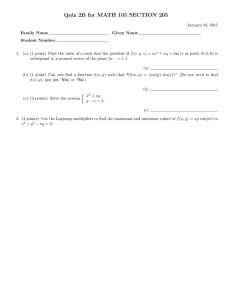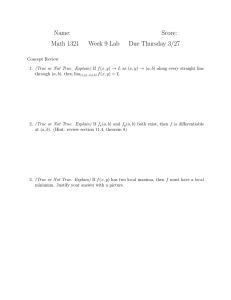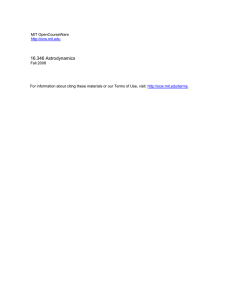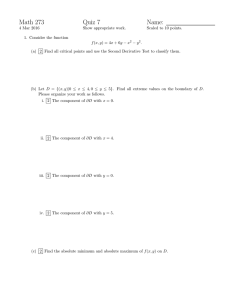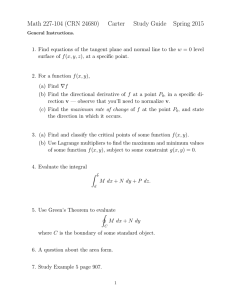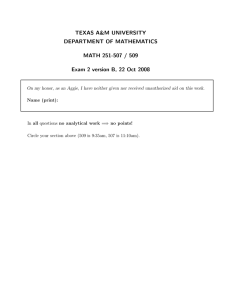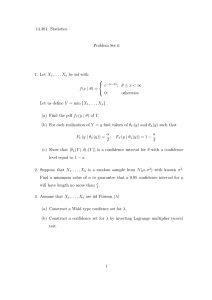16.346 Astrodynamics MIT OpenCourseWare .
advertisement
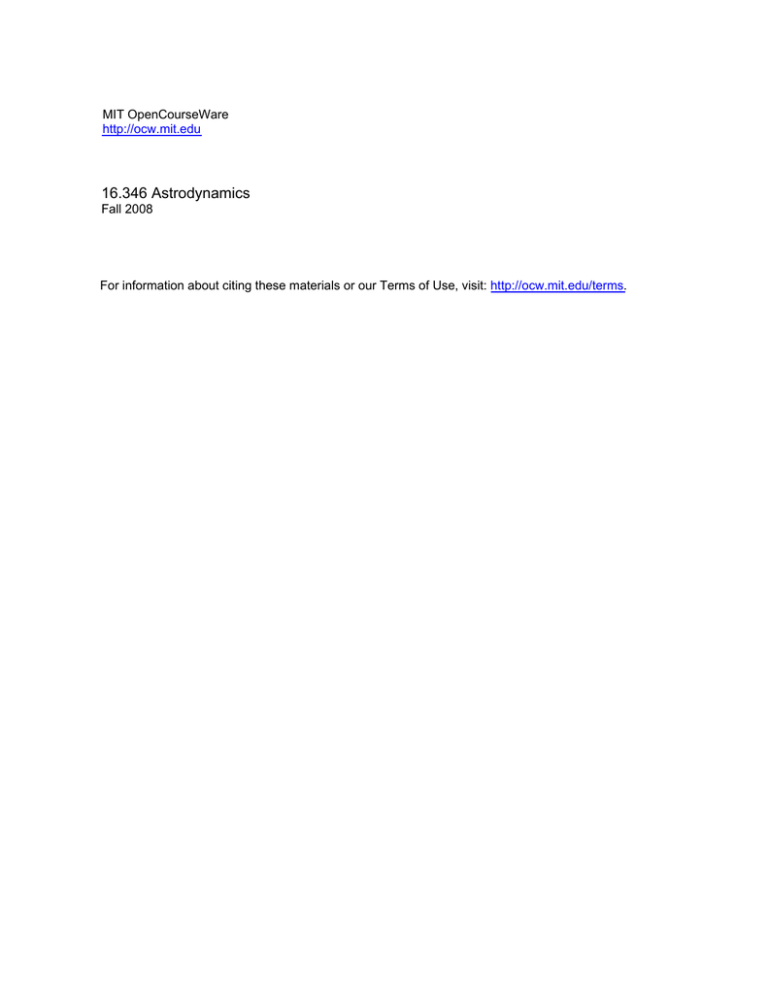
MIT OpenCourseWare http://ocw.mit.edu 16.346 Astrodynamics Fall 2008 For information about citing these materials or our Terms of Use, visit: http://ocw.mit.edu/terms. Lecture 32 Powered Flight Guidance to Maximize Final Energy Lagrange Multipliers Example Consider a simple example of the use of Lagrange Multipliers: Find the point on the curve x2 y = 2 which is nearest the origin. Here we must make x2 + y 2 a minimum subject to the constraint x2 y − 2 = 0. Solution: Find the minimum of the function f (x, y) = x2 + y 2 − λ(x2 y − 2) when x and y are unconstrained: ∂f ∂f = 2x − λ2xy = 0 = 2y − λx2 = 0 ∂x ∂y √ from which we find: λ = 1 √ x = ± 2√ y = 1 so that the two points at minimum distance from the origin are 2, 1 and − 2, 1. Thrust Vector Attitude Control to Maximize Total Energy State Equations ⎡ ⎤ ⎡ ⎤ x vx d ⎢ y ⎥ ⎢ vy ⎥ ⎣ ⎦ = ⎣ ⎦ ⇐⇒ v cos β(t) a dt x T aT sin β(t) − g vy dx = f [x(t), β(t)] dt Performance Index J = gy(t1 ) + 1 2 [vx2 (t1 ) + vy2 (t1 )] ⇐⇒ J = gx2 (t1 ) + 1 2 [x23 (t1 ) + x24 (t1 )] Admissible Variations x(t) = xm (t) + α(t) β(t) = βm (t) + αγ(t) with (t0 ) = 0 Lagrange Multipliers Introduce the vector Lagrange Multiplier λ(t) (also called the Co-State) and write � t1 � � dx λT(t) − f [x(t), β(t)] dt = 0 I= dt t0 The Problem To maximize J − I as a function of α dJ �� = g2 (t1 ) + x3m (t1 )3 (t1 ) + x4m (t1 )4 (t1 ) � dα α=0 � t1 � d ∂f ∂f � dI �� T = λ (t) − − γ dt � ∂x ∂β dα α=0 dt t0 16.346 Astrodynamics Lecture 32 Integration by Parts � t1 � d ∂f ∂f � dI �� = λT(t) γ dt − − � dt ∂x ∂β dα α=0 t0 �t1 � t1 � T � t1 � � ∂f ∂f dλ T T � − = λ (t)(t)� + λ (t) (t) dt − λT(t) γ(t) dt ∂β dt ∂x t0 t0 t0 � t1 ∂f dJ �� = λT(t1 )(t1 ) − λT(t) γ(t) dt must equal � ∂β dα α=0 t0 Here we require the Co-State λ (t) to satisfy the differential equation In our case ⎡ 0 ∂f ⎢ 0 = ⎣ 0 ∂x 0 ∂f dλ T = −λ T dt ∂x ⎤ 0 1 0 0 0 1⎥ ⎦ 0 0 0 0 0 0 so that ⎡ λ1 (t) = c1 λ2 (t) = c2 Also λ3 (t) = c1 t + c3 λ4 (t) = c2 t + c4 ⎤ 0 ∂f ⎢ 0 ⎥ = ⎣ ⎦ −aT sin β ∂β aT cos β Choose the constants c1 , c2 , c3 , c4 so that λ1 (t) = 0 λ2 (t) = g Then, if we are to have dI �� dJ �� =0 � − � dα α=0 dα α=0 λ3 (t) = vxm (t1 ) λ4 (t) = g(t1 − t) + vym (t1 ) � t1 λ T(t) we must require that t0 ∂f γ(t) dt = 0 ∂β From the Fundamental Lemma of the Calculus of Variations it follows that λ T(t) ∂f =0 ∂β which is called the Optimality Condition. In our case, we have −λ3 (t) sin βm (t) + λ4 (t) cos βm (t) = 0 Thus, the optimum program for β(t) is g(t1 − t) + vym (t1 ) λ4 (t) = tan βm (t) = λ3 (t) vxm (t1 ) called the Linear-Tangent Law. This result formed the basis of the so-called Iterated Guidance Mode used by the Saturn launch vehicle’s guidance system to place the Apollo spacecraft in an earth parking orbit prior to its voyage to the moon. 16.346 Astrodynamics Lecture 32
